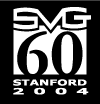


Alan George was born on November 9, 1943. He attended the University of Alberta where he received Bachelor and Master's degrees in 1964 and 1966 respectively. He was an instructor at the University of Alberta for a year before enrolling in doctoral studies at Stanford University, where he received a Ph.D. in Computer Science in 1971. After graduation, he joined the Computer Science Department at the University of Waterloo. He served as Dean of the Faculty of Mathematics from 1980 to 1986. From 1986 to 1988 he held the position of Distinguished Scientist at the Oak Ridge National Laboratory and University Professor of Mathematics and Computer Science at the University of Tennessee at Knoxville. In 1988 Alan returned to the University of Waterloo as Vice-President, Academic & Provost, completing a five-year term on June 30, 1993. Currently, he is again serving as Dean of the Faculty of Mathematics, a position to which he was appointed in 1998.
Alan's research interests involve large-scale scientific computation and related aspects of mathematical software. He is most well known for his contributions in the area of sparse matrix computation. With his students, he has developed a widely-used mathematical software package (SPARSPAK) for solving large sparse systems of equations and sparse least squares problems. In 1982 he was awarded the George E. Forsythe Memorial Prize for Leadership in Numerical Mathematics by the Association for Computing Machinery. He is a a Fellow of the Institute for Electrical and Electronics Engineers, a Fellow of the Institute for Mathematics and its Applications, and a Fellow of the Royal Society of Canada.

Michael Saunders was born on January 6, 1944. He received his B.Sc. in Mathematics at the University of Canterbury in 1965. In 1967 Mike came to the CS Dept at Stanford, where he worked under the direction of Gene Golub. His dissertation on "Large-scale linear programming using the Cholesky factorization" set the scene for his career in both linear algebra and optimization. With the exception of two stints in New Zealand (1973-74 and 1977-78), Mike remained at Stanford in the Systems Optimization Laboratory (SOL). He was appointed Research Professor in 1987.
With close colleagues at Stanford and beyond, Mike has done pioneering work in sparse matrix computation and large-scale numerical optimization. He is best known for his work with Down Under colleagues Chris Paige (on SYMMLQ, MINRES and LSQR) and Bruce Murtagh (on MINOS), as well as 30 years of collaboration with Philip Gill and Walter Murray -- most recently on SNOPT. (One of those decades included Margaret Wright as part of the famous Gang of Four at SOL.) MINOS has long served as the workhorse optimization code for many in industry and academia. In 1985 Mike won the Orchard-Hays Prize for excellence in computational mathematical programming.
Mike has an almost-secret twin brother David, who came to Stanford in 1970 for a "one month visit". With more care from Gene Golub, David also graduated in Computer Science. He has been at NASA Ames ever since, applying optimization methods to the design of aerospace vehicles such as supersonic airliners and the next space shuttle (most recently with help from SNOPT).

Jim Varah was born on July 18, 1943. He received his B.Sc. from the University of British Columbia (UBC) in 1963, his M.Sc. from Stanford in 1965, and two years later, at the young age of 24, his Ph.D. from Stanford. After a stint as the NRC Postdoctoral Fellow (1967-68) he took the position of Assistant Professor at the California Institute of Technology, and was there from 1969 to 1971. In 1971 he returned to UBC for a permanent position in the Computer Science Department, and held this position until his retirement in 2002. He was a Killam Senior Fellow in 1980-81 and a Visiting Professor at University of Waterloo in 1982-83. From 1984 to 1987 he was Chair of the Computer Science Department at UBC, and from 1986 to 1996 he was Director of the Centre for Integrated Computer Systems Research.
Jim's research interests are in numerical analysis and computation. Early in his career he made important contributions to research in the area of stability of boundary conditions for finite difference schemes. Later on, Jim focused his interests on numerical linear algebra and data fitting. His contributions span many years of active research and include solution methods of sparse linear systems, the design of fast algorithms for generating smooth data fits with applications in graphics and robotics, inverting shape from moments, and many contributions in matrix analysis.